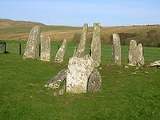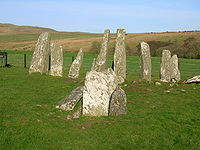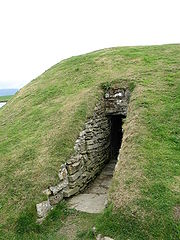
Chambered cairn
Encyclopedia
A chambered cairn is a burial monument, usually constructed during the Neolithic
, consisting of a cairn
of stones inside which a sizeable (usually stone) chamber was constructed. Some chambered cairns are also passage-graves
.
Typically, the chamber is larger than a cist
, and will contain a larger number of interments, which are either excarnated
bones or inhumations (cremations). Most were situated near a settlement, and served as that community's "graveyard".

 Scotland has a particularly large number of chambered cairns, many of radically different type. Because of the lack of other remains (the only other significant remains we have are hut circles and field systems), they are perhaps the most important clue we have to what civilisation in Scotland was like in the Neolithic. Here is a short description of each type as the classification currently stands:
Scotland has a particularly large number of chambered cairns, many of radically different type. Because of the lack of other remains (the only other significant remains we have are hut circles and field systems), they are perhaps the most important clue we have to what civilisation in Scotland was like in the Neolithic. Here is a short description of each type as the classification currently stands:
and in mostly southwestern Scotland. Lacking a significant passage, they are a form of gallery grave
. The very basic burial chamber is normally located at one end of the cairn, while a roofless, semi-circular forecourt at the entrance provided access from the outside (although the entrance was usually blocked), and gives this type of chambered cairn its alternate name of court tomb or court cairn. They are generally considered to be the earliest in Scotland, dating perhaps to as early as 4000 BCE, and probably spread to Scotland from Ireland
.
, and have a crude polygonal chamber and a very short passage to one end of the cairn.
 The Orkney-Cromarty group is by far the largest and most diverse. It has been subdivided into Yarrows, Camster and Cromarty subtypes but the differences are extremely subtle. In general, they all have dividing slabs at either side of a rectangular chamber, separating it into compartments. The number of these compartments ranges from 4 in the earliest examples to over 24 in an extreme example on Orkney. The actual shape of the cairn varies from simple circular designs to elaborate 'forecourts' protruding from each end, creating what look like small Amphitheatres. It is likely that these are the result of cultural influences from mainland Europe
The Orkney-Cromarty group is by far the largest and most diverse. It has been subdivided into Yarrows, Camster and Cromarty subtypes but the differences are extremely subtle. In general, they all have dividing slabs at either side of a rectangular chamber, separating it into compartments. The number of these compartments ranges from 4 in the earliest examples to over 24 in an extreme example on Orkney. The actual shape of the cairn varies from simple circular designs to elaborate 'forecourts' protruding from each end, creating what look like small Amphitheatres. It is likely that these are the result of cultural influences from mainland Europe
, as they are similar to designs found in France
and Spain
.
. Because of Orkney's archaeological richness, Bookan type tombs are very hard to find. They are extremely unusual, some being double-deckered! They all seem to have features which suggest some early stage in the development of Maeshowe type tombs.
group, named after the famous monument on Orkney, is among the most elaborate. Like their counterparts on Shetland
, they are unlike anything else in Scotland, so it is possible these were the result of local development, or influences from Scandinavia
. They consist of a central chamber from which lead small compartments, into which burials would be placed.
Neolithic
The Neolithic Age, Era, or Period, or New Stone Age, was a period in the development of human technology, beginning about 9500 BC in some parts of the Middle East, and later in other parts of the world. It is traditionally considered as the last part of the Stone Age...
, consisting of a cairn
Cairn
Cairn is a term used mainly in the English-speaking world for a man-made pile of stones. It comes from the or . Cairns are found all over the world in uplands, on moorland, on mountaintops, near waterways and on sea cliffs, and also in barren desert and tundra areas...
of stones inside which a sizeable (usually stone) chamber was constructed. Some chambered cairns are also passage-graves
Passage grave
thumb|250px|right|A simple passage tomb in [[Carrowmore]] near [[Sligo]] in IrelandA passage grave or passage tomb consists of a narrow passage made of large stones and one or multiple burial chambers covered in earth or stone. Megaliths are usually used in the construction of passage tombs, which...
.
Typically, the chamber is larger than a cist
Cist
A cist from ) is a small stone-built coffin-like box or ossuary used to hold the bodies of the dead. Examples can be found across Europe and in the Middle East....
, and will contain a larger number of interments, which are either excarnated
Excarnation
In archaeology and anthropology, the term, excarnation , refers to the burial practice of removing the flesh and organs of the dead, leaving only the bones....
bones or inhumations (cremations). Most were situated near a settlement, and served as that community's "graveyard".
In Scotland


Clyde-Carlingford court cairns
The Clyde-Carlingford type are to be found in northern and western IrelandIreland
Ireland is an island to the northwest of continental Europe. It is the third-largest island in Europe and the twentieth-largest island on Earth...
and in mostly southwestern Scotland. Lacking a significant passage, they are a form of gallery grave
Gallery grave
A Gallery grave is a form of Megalithic tomb where there is no size difference between the burial chamber itself and the entrance passage. Two parallel walls of stone slabs were erected to form a corridor and covered with a line of capstones. The rectangular tomb was covered with a barrow or a cairn...
. The very basic burial chamber is normally located at one end of the cairn, while a roofless, semi-circular forecourt at the entrance provided access from the outside (although the entrance was usually blocked), and gives this type of chambered cairn its alternate name of court tomb or court cairn. They are generally considered to be the earliest in Scotland, dating perhaps to as early as 4000 BCE, and probably spread to Scotland from Ireland
Ireland
Ireland is an island to the northwest of continental Europe. It is the third-largest island in Europe and the twentieth-largest island on Earth...
.
Hebridean
Sharing some features with the Clyde-Carlingford group is the Hebridean group. As their name suggests they are normally found in the HebridesHebrides
The Hebrides comprise a widespread and diverse archipelago off the west coast of Scotland. There are two main groups: the Inner and Outer Hebrides. These islands have a long history of occupation dating back to the Mesolithic and the culture of the residents has been affected by the successive...
, and have a crude polygonal chamber and a very short passage to one end of the cairn.
Orkney-Cromarty

Europe
Europe is, by convention, one of the world's seven continents. Comprising the westernmost peninsula of Eurasia, Europe is generally 'divided' from Asia to its east by the watershed divides of the Ural and Caucasus Mountains, the Ural River, the Caspian and Black Seas, and the waterways connecting...
, as they are similar to designs found in France
France
The French Republic , The French Republic , The French Republic , (commonly known as France , is a unitary semi-presidential republic in Western Europe with several overseas territories and islands located on other continents and in the Indian, Pacific, and Atlantic oceans. Metropolitan France...
and Spain
Spain
Spain , officially the Kingdom of Spain languages]] under the European Charter for Regional or Minority Languages. In each of these, Spain's official name is as follows:;;;;;;), is a country and member state of the European Union located in southwestern Europe on the Iberian Peninsula...
.
Bookan
The Bookan type is thought to be the earliest to be found on OrkneyOrkney Islands
Orkney also known as the Orkney Islands , is an archipelago in northern Scotland, situated north of the coast of Caithness...
. Because of Orkney's archaeological richness, Bookan type tombs are very hard to find. They are extremely unusual, some being double-deckered! They all seem to have features which suggest some early stage in the development of Maeshowe type tombs.
Maeshowe
The MaeshoweMaeshowe
Maeshowe is a Neolithic chambered cairn and passage grave situated on Mainland, Orkney, Scotland. The monuments around Maeshowe, including Skara Brae, were designated a UNESCO World Heritage Site in 1999. It gives its name to the Maeshowe type of chambered cairn, which is limited to Orkney...
group, named after the famous monument on Orkney, is among the most elaborate. Like their counterparts on Shetland
Shetland Islands
Shetland is a subarctic archipelago of Scotland that lies north and east of mainland Great Britain. The islands lie some to the northeast of Orkney and southeast of the Faroe Islands and form part of the division between the Atlantic Ocean to the west and the North Sea to the east. The total...
, they are unlike anything else in Scotland, so it is possible these were the result of local development, or influences from Scandinavia
Scandinavia
Scandinavia is a cultural, historical and ethno-linguistic region in northern Europe that includes the three kingdoms of Denmark, Norway and Sweden, characterized by their common ethno-cultural heritage and language. Modern Norway and Sweden proper are situated on the Scandinavian Peninsula,...
. They consist of a central chamber from which lead small compartments, into which burials would be placed.
Shetland
A final category is the Shetland group, of which little is known. On plan, they do look similar to the Maeshowe group although the whole chamber is cross-shaped and there are no small compartments.Carneddau cellog hir (chambered long cairns)
There are 18 SAM listed:- Siambr gladdu Din Dryfol, AberffrawAberffrawAberffraw is a small village and community on the south west coast of the Isle of Anglesey , in Wales, by the west bank of the River Ffraw, at . The UK postcode begins LL63. Access by road is by way of the A4080 and the nearest rail station is Bodorgan. In the early Middle Ages Aberffraw was the...
- Carnedd gellog hir Pen y Wyrlod, TalgarthTalgarthTalgarth is a small market town and community in southern Powys , Mid Wales, with a population of 1,645. Notable buildings in the town include its 14th-century parish church and 13th century Pele Tower, located in the town centre, now home to the Tourist Information and Resource Centre...
- Siambr gladdu Llety'r Filiast, LlandudnoLlandudnoLlandudno is a seaside resort and town in Conwy County Borough, Wales. In the 2001 UK census it had a population of 20,090 including that of Penrhyn Bay and Penrhynside, which are within the Llandudno Community...
- Siambr gladdu Bachwen, Clynnog
- Siambr gladdu Rhiw, AberdaronAberdaronAberdaron is a community and former fishing village at the western tip of the Llŷn Peninsula in the Welsh county of Gwynedd. It lies west of Pwllheli and south west of Caernarfon, and has a population of 1,019. It is sometimes referred to as the "Land's End of Wales"...
- Siambr gladdu Maen y Bardd, CaerhunCaerhunCaerhun is a village and rural community on the west bank of the River Conwy, to the south of Henryd and to the north of Dolgarrog, in Conwy County Borough, north Wales. The population was 1200 at the 2001 Census.-Features:...
- Siambr gladdu Ystum-Cegid, LlanystumdwyLlanystumdwyLlanystumdwy is a village and community on the Llŷn Peninsula of Gwynedd in Wales, although it is not regarded as being part of Llŷn, but belonging instead to the local region of Eifionydd...
- Siambr gladdu Caer-Dynni, Cricieth
- Siambr gladdu Capel Garmon, Bro Garmon, ConwyConwyConwy is a walled market town and community in Conwy County Borough on the north coast of Wales. The town, which faces Deganwy across the River Conwy, formerly lay in Gwynedd and prior to that in Caernarfonshire. Conwy has a population of 14,208...
- Siambr gladdu Tyddyn Bleiddyn, Cefn Meiriadog
- Siambr gladdu Hendre-Waelod, Llansanffraid Glan Conwy
- Siambr gladdu Parc le BreosParc Cwm long cairnParc Cwm long cairn , also known as Parc le Breos burial chamber , is a partly restored Neolithic chambered tomb, identified in 1937 as a Severn-Cotswold type of chambered long barrow. The cromlech, a megalithic burial chamber, was built around 5850 years before present , during the early...
, Llanilltud Gŵyr - Siambr gladdu Cefn Bryn, Llanilltud Gŵyr
- Siambr gladdu Dyffryn, Dyffryn ArdudwyDyffryn ardudwyDyffryn Ardudwy is a village and community in the Ardudwy area of Gwynedd, Wales. It has a population of 1,654.The village of Dyffryn Ardudwy is situated on the A496 costal road between the towns of Harlech and Barmouth and at the foot of Moelfre, part of the Rhinogydd range.There are a number of...
- Siambr gladdu Carneddau Hengwm, Dyffryn ArdudwyDyffryn ardudwyDyffryn Ardudwy is a village and community in the Ardudwy area of Gwynedd, Wales. It has a population of 1,654.The village of Dyffryn Ardudwy is situated on the A496 costal road between the towns of Harlech and Barmouth and at the foot of Moelfre, part of the Rhinogydd range.There are a number of...
- Siambr gladdu Cors-y-Gedol, Dyffryn ArdudwyDyffryn ardudwyDyffryn Ardudwy is a village and community in the Ardudwy area of Gwynedd, Wales. It has a population of 1,654.The village of Dyffryn Ardudwy is situated on the A496 costal road between the towns of Harlech and Barmouth and at the foot of Moelfre, part of the Rhinogydd range.There are a number of...
- Siambr gladdu Tan-y-Coed, LlandrilloLlandrilloLlandrillo may refer to one of the following in North Wales, UK:* Llandrillo, Denbighshire* Coleg Llandrillo Cymru, a multi-campus college* Rhos-on-Sea , a suburb of Colwyn Bay...
- Siambr gladdu Gorllewin Bron-y-Foel, Dyffryn ArdudwyDyffryn ardudwyDyffryn Ardudwy is a village and community in the Ardudwy area of Gwynedd, Wales. It has a population of 1,654.The village of Dyffryn Ardudwy is situated on the A496 costal road between the towns of Harlech and Barmouth and at the foot of Moelfre, part of the Rhinogydd range.There are a number of...
Chambered round cairns
- Siambr gladdu Bryn yr Hen Bobl, Llanddaniel FabLlanddaniel FabLlanddaniel Fab is a village in the ward of Llanidan, southern Anglesey, Wales.It is near the prehistoric monument of Bryn Celli Ddu which was constructed in the late neolithic period....
, MônMon-Places:* Mon State, a subdivision of Burma* Mon, Nagaland, a town in India* Mon District, Nagaland, India* Mon, Switzerland, a village in the Grisons* Isle of Anglesey or Môn, an island and county of Wales* Møn, an island of Denmark... - Siambr gladdu Gelli, Llanfair-ar-y-brynLlanfair-ar-y-brynLlanfair-ar-y-bryn is a community located on the A483 just north of Llandovery in Carmarthenshire, Wales.The Llanfair-ar-y-bryn church stands on the Alabum site, a Roman auxiliary fort, and was the parish church until 1883. William Williams Pantycelyn who is generally acknowledged as Wales's most...
, Sir Gaerfyrddin - Siambr gladdu Cefnamwlch, TudweiliogTudweiliogTudweiliog is a small, predominantly Welsh speaking village and community on the northern coast of the Llŷn Peninsula in the Welsh county of Gwynedd...
, GwyneddGwyneddGwynedd is a county in north-west Wales, named after the old Kingdom of Gwynedd. Although the second biggest in terms of geographical area, it is also one of the most sparsely populated... - Siambr galddu Afon y Dolau Gwynion, uwch ben Llyn Llanwddyn, Llanwddyn, PowysPowysPowys is a local-government county and preserved county in Wales.-Geography:Powys covers the historic counties of Montgomeryshire and Radnorshire, most of Brecknockshire , and a small part of Denbighshire — an area of 5,179 km², making it the largest county in Wales by land area.It is...

